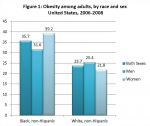In 2010, the Centers for Disease Control and Prevention (CDC) reported the following:
•One-third of American adults are obese—meaning they are not only overweight, but they have a body mass index (BMI) higher than 30 (see Resources for more definitions and information).
 |
• In 1991, no U.S. state had obesity rates at or above 20 percent. By 2010, no state had a prevalence of obesity below 20 percent, and 36 states had a prevalence of 25 percent or more. Twelve of those states had a prevalence of 30 percent or more.
•As of 2008, 27.1 percent of adults in Allegheny County were obese.
•Non-Hispanic African Americans have the highest rates of obesity.
Every day, we are bombarded with messages about how many Americans are obese. We’ve probably all seen the statistics above and know that our lifestyles could be healthier.
But, obesity is more than just being “fat.” Body weight is a complex combination of genetic, metabolic, behavioral, environmental, cultural and socioeconomic influences.
What’s especially alarming is that the rate of obesity in African Americans is higher than any other racial group. Why? The answer is still complex, but the CDC cites three possible reasons for the disparity. First, behaviors that contribute to weight gain are different among various ethnic or racial groups. Second, these groups view body weight through different cultural lenses, and people with larger weights are not always viewed negatively. Finally, many of us live in communities in which the only food available is from gas stations, fast food restaurants or convenience stores and in which recreational facilities are scarce, sidewalks are in disrepair and neighborhood safety is a serious issue. An article published in the October 20, 2011, issue of the New England Journal of Medicine reported that neighborhood environments are linked to the occurrence of diabetes and obesity. In recent decades, America’s neighborhoods have become more segregated, and a larger proportion of the population (especially minorities) is being exposed to distressed neighborhood environments.
Despite these challenges, we need to focus on our lifestyles—for the sake of our children, who learn from us and our habits, and for our own sake. Obesity can lead to many health complications, including diabetes, heart disease, mental illness and the risk of cancer, among others.
Let’s talk about prevention. What can you do if you’re worried about becoming or being obese or overweight? The first step is examining what you eat. Silva Arslanian, MD, Richard L. Day Professor of Pediatrics at the University of Pittsburgh School of Medicine and director of the Weight Management and Wellness Center at Children’s Hospital of Pittsburgh of UPMC, has some tips for adjusting your diet, including minimizing the number of calories you drink from soda, juice or other drinks with little to no nutritional value; replacing snacks with healthier choices; minimizing your intake of fast food; and eating breakfast and sitting down with your family to eat meals (both are associated with lower BMIs and lower body weights).
The second step is measuring your activity level and determining whether you get enough daily exercise. If not, find some ways to insert some activity into your life. Maybe you can walk to school, work, church or other places, or take the stairs whenever possible. Involve your family; maybe your children want to run around with you at a playground or take a walk. Try to change sedentary behavior by limiting television or computer time to 30 minutes to one hour a day.
Third, think of other ways to create a healthier environment. Ask community leaders to help get grocery stores or farmers’ markets into your neighborhood. Encourage family members and friends to bring healthier food to social gatherings. Most importantly, find support. Involve your entire family, a good friend or a health care professional in your choice to live a healthier lifestyle. It’s easier to make big lifestyle changes when you have people you trust helping you.
The statistics about obesity are alarming and discouraging, but don’t let them stop you and your family from being as healthy as you can be. Do what you can to live a longer, healthier life with your loved ones. Take charge of your health today. Be informed. Be involved.
For more information, please contact Community PARTners at 1-866-422-1575, PARTners@hs.pitt.edu, or visit our Web site at https://www.ctsi.pitt.edu.